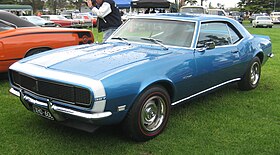| Chevrolet Camaro (first generation) | |
|---|---|
 1968 Camaro RS 327 | |
| Overview | |
| Manufacturer | Chevrolet (General Motors) |
| Production | September 29, 1966–November 1969[1] |
| Model years | 1967–1969 |
| Assembly | |
| Designer | Henry Haga |
| Body and chassis | |
| Class | |
| Body style |
|
| Layout | FR layout |
| Platform | F-body |
| Related | Pontiac Firebird (first generation) |
| Powertrain | |
| Engine | |
| Transmission |
|
| Dimensions | |
| Wheelbase | 108 in (2,743 mm) |
| Length | 184.7 in (4,691 mm) (MY1967) [3] 184.7 in (4,691 mm) (MY1968) [4] 186.0 in (4,724 mm) (MY1969) [5] |
| Width |
|
| Height |
|
| Chronology | |
| Successor | Chevrolet Camaro (second generation) |
The first-generation Chevrolet Camaro is an American pony car introduced by Chevrolet in the fall of 1966 for the 1967 model year. It used a brand-new rear-wheel-drive GM F-body platform and was available as a 2-door, 2+2 seat, hardtop, and convertible. The F-body was shared with the Pontiac Firebird for all generations. A 230 cu in Chevrolet straight-6 was standard, with several Chevy V8s available as options.[6][7] The first-generation Camaro was built through the 1969 model year.
Almost all of 1967–1969 Camaros were built in the two U.S. assembly plants: Norwood, Ohio, and Van Nuys, California. There were also five non-U.S. Camaro assembly plants in countries that required local assembly and content. These plants were located in the Philippines, Belgium, Switzerland, Venezuela, and Peru.[8]
- ^ Davis, Marlan (November 4, 2020). "1969 Camaro Options and Trim Codes Explained". Motor Trend. Retrieved April 26, 2024.
1969 Camaro's extended production run from August 1968 through November 1969 (a union strike delayed the all-new 1970 models),
- ^ Braunschweig, Robert, ed. (March 9, 1967). Automobil Revue Modelle 1967/Revue Automobile modèles 1967 (in German and French). Vol. 62. Berne, Switzerland: Hallwag. p. 222.
{{cite magazine}}: Missing or empty|title=(help) - ^ "1967 Chevrolet Camaro - information kit" (PDF). GM Heritage Center. September 1966. Retrieved March 13, 2016.
- ^ "1968 Chevrolet Camaro - information kit" (PDF). GM Heritage Center. Retrieved March 13, 2016.
- ^ "1969 Chevrolet Camaro - information kit" (PDF). GM Heritage Center. September 1968. Retrieved March 13, 2016.
- ^ Strohl, Daniel (July 6, 2011). "Down the throat: the introduction of the 1967 Camaro". Hemmings Daily. Retrieved March 13, 2016.
- ^ Kilpatrick, Bill (October 1966). "The really new ones". Popular Mechanics. Vol. 126, no. 4. pp. 105–108. Retrieved March 13, 2016.
- ^ Sonen, Kurt (November 26, 2013). "Camaro Foreign Assembly Plants". Camaros.org. Retrieved January 26, 2018.